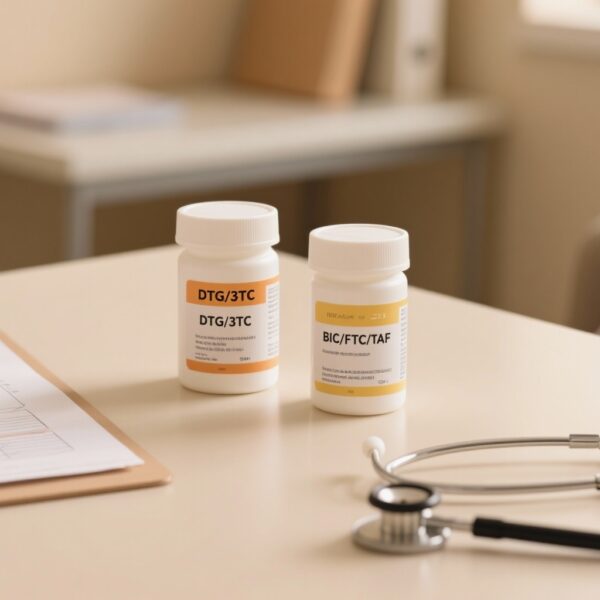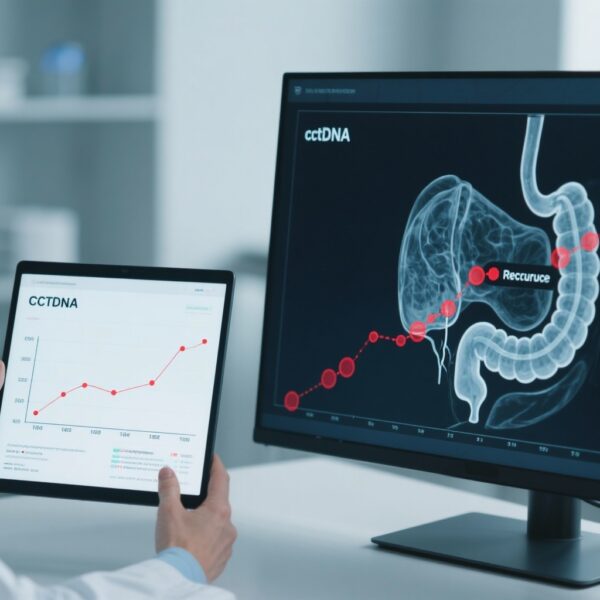Highlights
• Dual TIGIT and PD‑1 blockade with domvanalimab and zimberelimab added to FOLFOX produced a confirmed objective response rate (ORR) of 59% in previously untreated HER2‑negative advanced gastric, gastroesophageal junction (GEJ) or esophageal adenocarcinoma (n=41).
• Median progression‑free survival (PFS) was 12.9 months and median overall survival (OS) was 26.7 months in the study cohort; responses were higher among PD‑L1–positive tumors.
• Immune‑related adverse events (irAEs) occurred in 27% of patients; overall safety was consistent with known toxicities of anti‑PD‑1 plus platinum‑based chemotherapy.
Background and unmet need
Advanced gastric and gastroesophageal junction adenocarcinomas remain aggressive malignancies with substantial morbidity and mortality globally. First‑line treatment for HER2‑negative disease has evolved from chemotherapy alone to combinations that incorporate immune‑checkpoint inhibitors targeting the PD‑1/PD‑L1 axis, improving survival for subsets of patients, particularly those with higher PD‑L1 expression. Despite these advances, many patients fail to achieve durable disease control, and response rates remain suboptimal in an unselected population. Strategies to deepen and prolong antitumor immune responses have therefore focused on rational combinations that target complementary immune checkpoints.
TIGIT (T cell immunoreceptor with Ig and ITIM domains) is an inhibitory receptor expressed on exhausted T cells and NK cells and can act cooperatively with PD‑1 to restrain antitumor immunity. Preclinical and early clinical data suggest that dual blockade of TIGIT and PD‑1 may enhance T cell function and synergize with cytotoxic chemotherapy to increase tumor antigen release and immune priming. The EDGE‑Gastric phase 2 program evaluates whether adding an Fc‑silent anti‑TIGIT antibody (domvanalimab) to anti‑PD‑1 therapy (zimberelimab) plus chemotherapy improves clinical outcomes in the first‑line and later lines of therapy for advanced gastroesophageal adenocarcinomas.
Study design (cohort A1)
EDGE‑Gastric is a multicenter, international, phase 2 trial with multiple cohorts addressing first‑line (cohort A) and later‑line (cohorts B, C) settings. The cohort A1 arm—reported in the present publication—was a nonrandomized evaluation of domvanalimab (an Fc‑silent anti‑TIGIT monoclonal antibody) plus zimberelimab (an anti‑PD‑1 monoclonal antibody) combined with FOLFOX chemotherapy (oxaliplatin, leucovorin, and fluorouracil) in patients with previously untreated, HER2‑negative advanced gastric, gastroesophageal junction, or esophageal adenocarcinoma.
Key eligibility criteria included measurable disease by RECIST, adequate organ function, and no prior systemic therapy for advanced disease. The primary efficacy endpoints reported were objective response rate (ORR) and key secondary endpoints included progression‑free survival (PFS), overall survival (OS), and safety. PD‑L1 expression was assessed by tumor area positivity with cutoffs reported at ≥1% (PD‑L1 positive) and ≥5% (PD‑L1 high).
Key findings
Patient population and treatment exposure
Forty‑one patients were treated in cohort A1. Baseline characteristics (age distribution, performance status, disease sites, and PD‑L1 expression strata) are summarized in the primary report. Patients received domvanalimab plus zimberelimab concurrently with FOLFOX per protocol.
Efficacy outcomes
The confirmed ORR in the intention‑to‑treat treated population was 59% (90% confidence interval [CI] 44.5–71.6%). Median PFS was 12.9 months (90% CI 9.8–14.6 months) and median OS was 26.7 months (90% CI 18.4 months to not estimable).
Stratified by PD‑L1 tumor area positivity, the efficacy signal was numerically greater in PD‑L1–positive and PD‑L1–high tumors. For patients with tumor area positivity ≥1% (PD‑L1 positive), ORR was 62% (90% CI 45.1–77.1%), median PFS 13.2 months (90% CI 11.3–15.2 months), and median OS 26.7 months (90% CI 19.5 months to not estimable). In the PD‑L1 ≥5% subgroup (PD‑L1 high), ORR was 69% (90% CI 45.2–86.8%), median PFS 14.5 months (90% CI 11.3 months to not estimable), and median OS was not reached (90% CI 17.4 months to not estimable).
These efficacy measures compare favorably with historical expectations for chemotherapy alone and are encouraging in the context of prior trials in which PD‑1 blockade plus chemotherapy demonstrated benefit in PD‑L1–expressing tumors. Importantly, median PFS beyond 12 months and median OS approaching or exceeding two years indicate potentially meaningful clinical activity in a first‑line population.
Safety and tolerability
The combination was generally tolerable and the overall safety profile was consistent with known toxicities of anti‑PD‑1 therapy plus platinum‑based chemotherapy. Immune‑related adverse events (irAEs) were reported in 27% of patients; the spectrum included events typically seen with PD‑1 inhibition (e.g., thyroid dysfunction, dermatitis, pneumonitis, hepatitis). Rates of grade ≥3 treatment‑related adverse events and immune‑related grade ≥3 events were described in the primary manuscript and align with expectations for such combinations. No new or unexpected safety signals attributable to TIGIT blockade were highlighted in the report.
Interpretation and biological rationale
The observed activity of domvanalimab and zimberelimab with FOLFOX supports the mechanistic hypothesis that simultaneous blockade of TIGIT and PD‑1 can reinvigorate exhausted T cells and enhance antitumor immunity beyond PD‑1 inhibition alone. Chemotherapy can increase antigen release and modulate the tumor microenvironment to favor immune infiltration, potentially augmenting the effects of immune‑checkpoint blockade. The higher response rates and longer PFS observed in PD‑L1–positive and PD‑L1–high subgroups are consistent with PD‑L1 remaining a useful, if imperfect, predictive biomarker for benefit from PD‑1–directed therapy and suggest that dual checkpoint blockade may further amplify responses in patients with baseline immune‑active tumors.
Clinical context and comparison with contemporary standards
Over the past several years, randomized phase 3 studies have established the benefit of adding PD‑1 inhibitors to chemotherapy in selected patients with advanced gastric/GEJ carcinoma, particularly those with higher PD‑L1 expression. The EDGE‑Gastric cohort A1 results add to growing data that combining additional immune‑modulatory agents with PD‑1 blockade may further improve outcomes. However, cross‑trial comparisons are limited by differences in patient selection, PD‑L1 assays and cutoffs, and trial design. A definitive determination of whether TIGIT plus PD‑1 blockade provides incremental benefit over PD‑1 blockade alone requires randomized phase 3 data; the regimen reported here is being evaluated in the phase 3 STAR‑221 trial.
Limitations and considerations
Key limitations of the reported cohort include nonrandomized design, modest sample size (n=41), and the potential for selection bias. Confidence intervals are wide, and the durability of benefit across broader, more heterogeneous populations remains to be established. Biomarker analyses beyond PD‑L1 tumor area positivity—such as tumor mutational burden, immune gene signatures, or intratumoral TIGIT expression—were not comprehensively reported and may be important for refining patient selection. Safety signals, particularly rare or late toxicities associated with immune modulation, will need continued monitoring in larger cohorts and randomized settings.
Expert commentary and future directions
The EDGE‑Gastric cohort A1 data provide an important signal that dual TIGIT/PD‑1 blockade combined with chemotherapy has the potential to increase response rates and extend progression‑free intervals in first‑line advanced gastric/GEJ/esophageal adenocarcinoma. These results justify ongoing phase 3 assessment (STAR‑221) to define efficacy versus current standard regimens and to identify patient subgroups most likely to benefit.
Future research priorities include: rigorous randomized comparison with PD‑1 inhibitor plus chemotherapy backbones; integrated translational studies to define predictive biomarkers and resistance mechanisms; optimal sequencing with HER2‑directed therapies where relevant; and long‑term safety surveillance for immune‑mediated events. Additionally, mechanistic studies to dissect the contributions of TIGIT blockade to T cell and NK cell biology in human tumors will inform combination strategies and rational biomarker development.
Conclusion
Domvanalimab (anti‑TIGIT) plus zimberelimab (anti‑PD‑1) combined with FOLFOX demonstrated encouraging efficacy and manageable toxicity in a phase 2 first‑line cohort of HER2‑negative advanced gastric, GEJ, and esophageal adenocarcinoma. The objective response rate of 59%, median PFS of 12.9 months, and median OS of 26.7 months—particularly the higher responses in PD‑L1–positive tumors—support further testing in randomized phase 3 trials. Confirmation of these findings and identification of predictive biomarkers will be crucial to define the clinical role of TIGIT inhibition in gastroesophageal cancers.
Funding and clinical trial registration
The EDGE‑Gastric study and the reported cohort were funded and conducted by multiple institutional and industry collaborators as described in the primary publication. The cohort reported here corresponds to ClinicalTrials.gov identifier NCT05329766.
References
1. Janjigian YY, Oh DY, Pelster M, Wainberg ZA, Prusty S, Nelson S, DuPage A, Thompson A, Koralek DO, Sison EAR, Rha SY. Domvanalimab and zimberelimab in advanced gastric, gastroesophageal junction or esophageal cancer: a phase 2 trial. Nat Med. 2025 Oct 18. doi: 10.1038/s41591-025-04022-w. Epub ahead of print. PMID: 41109921.
2. EDGE‑Gastric phase 2 trial registration, ClinicalTrials.gov Identifier: NCT05329766. Available at: https://clinicaltrials.gov/ct2/show/NCT05329766 (accessed 2025).
Thumbnail image prompt
A high-resolution clinical-style image of a multidisciplinary oncology team (medical oncologist, radiologist, research nurse) reviewing CT scans and molecular pathology reports on a lightbox and tablet; include schematic translucent overlays of T cells and antibody structures to symbolize immunotherapy; cool clinical color palette, clear focus on collaboration and precision medicine; photorealistic, editorial composition.



